Full List Of India’s Air Defence Systems
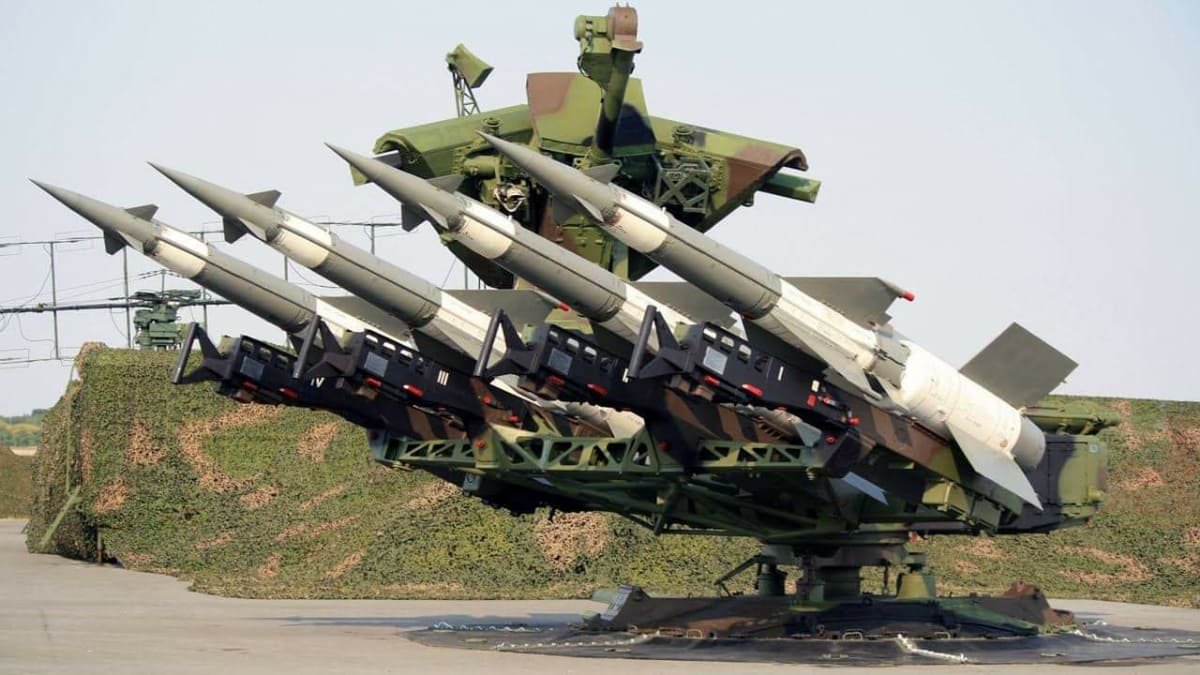
- Ground-based air defence systems play a crucial role in a country’s defence. These are the goalkeepers of the skies. The Indian air force is right now struggling to maintain its squadron strength. In such a scenario the role of air defence systems becomes very important. In this article, we are going to look at the various types of air defence systems India operates.
- India is currently developing multi-layer air defence system. Multi-layer air defence system would ensure successful interception of incoming areal threats. India’s multi-layer air defence system would consist of four layers as mentioned below.
Components of Air Defence
- Long Range interception: Indian Ballistic Missile Defence Programme
- Intermediate Interception: S-400 Triumph (future induction)
- Short Range interception: Akash Air Defense System and Similar Systems
- Very Short-range interception: MANPADS and Anti- Aircraft Guns.
Indian Ballistic Missile Defence Programme
The Indian Ballistic Missile Defence Program is an initiative to develop and deploy a multi-layered ballistic missile defence system to protect India from ballistic missile attacks. Introduced in light of the ballistic missile threat from Pakistan, and China, it is a double-tiered system consisting of two land and sea-based interceptor missiles, namely the Prithvi Air Defence (PAD) missile for high altitude interception, and the Advanced Air Defence (AAD) Missile for lower altitude interception. The two-tiered shield should be able to intercept any incoming missile launched from 5,000 kilometres away. The system also includes an overlapping network of early warning and tracking radars, as well as command and control posts.
Prithvi Air Defence (PAD) missile

The Prithvi Air Defence (PAD) is an anti-ballistic missile developed to intercept incoming ballistic missiles outside the atmosphere (exo-atmospheric).
It has an operational range of 300 km -2000 km. It has maximum interception altitude of 80 km. it is designed to intercept incoming ballistic missiles in their intermediate cruising phase. With a maximum speed over Mach 5, PAD is fast enough to hit intermediate-range ballistic missiles.
It is a two-stage missile. The first stage is a Solid fuelled motor while the second stage is Liquid fuelled. It has manoeuvre thrusters which can generate a lateral acceleration of more than 5 gs at 50 km (31 mi) altitude. Guidance is provided by an inertial navigation system with mid-course updates from LRTR and active radar homing in the terminal phase.LRTR is the target acquisition and fire control radar for the PAD missile. It is an active phased array radar having the capability to track 200 targets at a range of 600 km
The first test was conducted in 2006 in which a PAD missile successfully intercepted a modified Prithvi-II Missile at an altitude of 50 km (31 mi). The Prithvi-II ballistic missile was modified successfully to mimic the trajectory of M-11 missiles.
Advanced Air Defence (AAD) Missile

Advanced Air Defence (AAD) is an anti-ballistic missile designed to intercept incoming ballistic missiles in the endo-atmosphere at an altitude of 30 km (19 mi). It is for those targets which somehow get passed through PAD. It is a secondary layer which compliments PAD.
AAD has an operational range of 150 km to 200 km. It has a maximum speed of Mach 4.5. AAD is a single-stage, solid-fuelled missile with siliconised carbon jet vanes. Guidance is similar to that of PAD with indigenous radio frequency seeker. It supports the inertial navigation system (INS), mid-course updates from ground-based radar and active radar homing in the terminal phase.
Short Range interception (less than 100 km)
Indian Army and Indian Air force operates a variety of systems in this segment. These mainly include Surface to Air Missiles (SAM) like Akash SAM, S-125 pechora, Spyder Air defense system etc
S-125 Pechora

S-125 Pechora is a surface to air missile system of Soviet origin. For a very long time, this system has been the backbone of Indian Air Force’s Air defence. This system is 60 years old as it was first inducted into service by the Soviet Union in 1961. This system has participated in almost every modern conflict. It has countless kills against various adversaries. IAF operates 25 squadrons of Pechora.
| Designer | Almaz Central Design Bureau |
| Maximum Speed | 3 to 3.5 Mach |
| Maximum Target Altitude | less than 20 km |
| Operational Range | 30 km |
| strength | 25 squadrons |
“If the enemy is in range, so are you”
Infantry journal
Akash Air Defence System
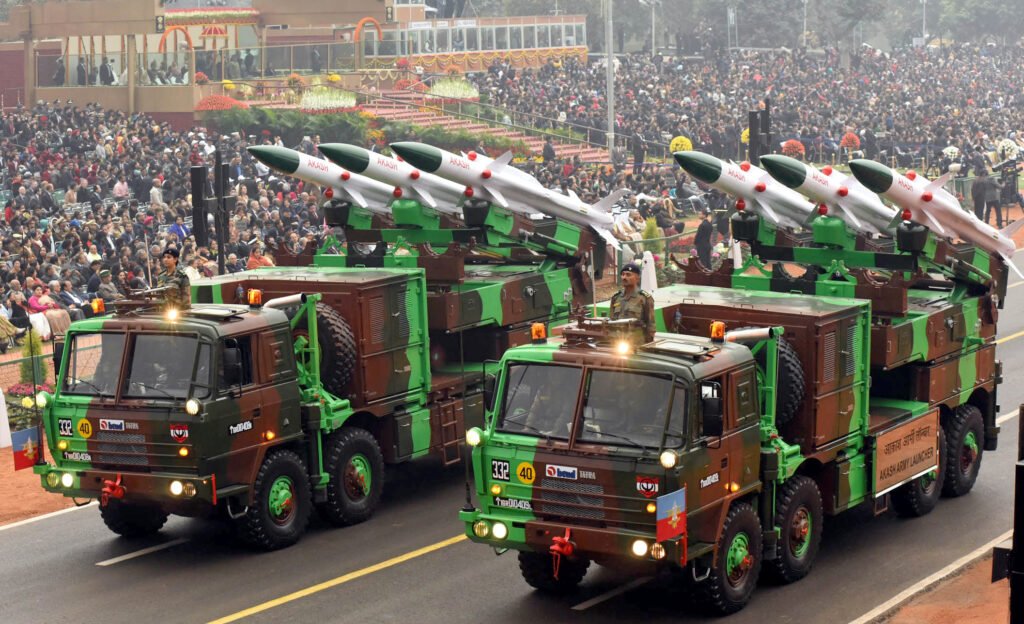
Akash is a medium-range mobile surface-to-air missile defence system developed by the Defence Research and Development Organisation (DRDO) and the missiles produced by Bharat Dynamics Limited.
The missile system can target aircraft up to 45 km away, at altitudes up to 18,000 m. It has the capability to neutralize aerial targets like fighter jets, cruise missiles and air-to-surface missiles as well as ballistic missiles.
An Akash battery comprises a single Rajendra 3D passive electronically scanned array radar and four launchers with three missiles each, all of which are interlinked. Each battery can track up to 64 targets and attack up to 12 of them.
| War head | 60 Kg Pre-fragmented High Explosive War Head |
| Propulsion | Solid booster and integral rocket/ramjet sustainer motor |
| Operational Range | 45 km |
| maximum Speed | Mach 3.5 |
| Guidance system | Mid-course: Command guidance with datalink Terminal: Active radar homing |
| Launch platform | T-72 or BMP-2 chassis or Tata Motors Heavy Mobility Trucks |
Indian Air force operates 8 squadrons of Akash air defense system. Indian Amy operates 2 regiments of it. Army has also placed order for 2 more regiments. read more about akash air defense system here.
SPYDER
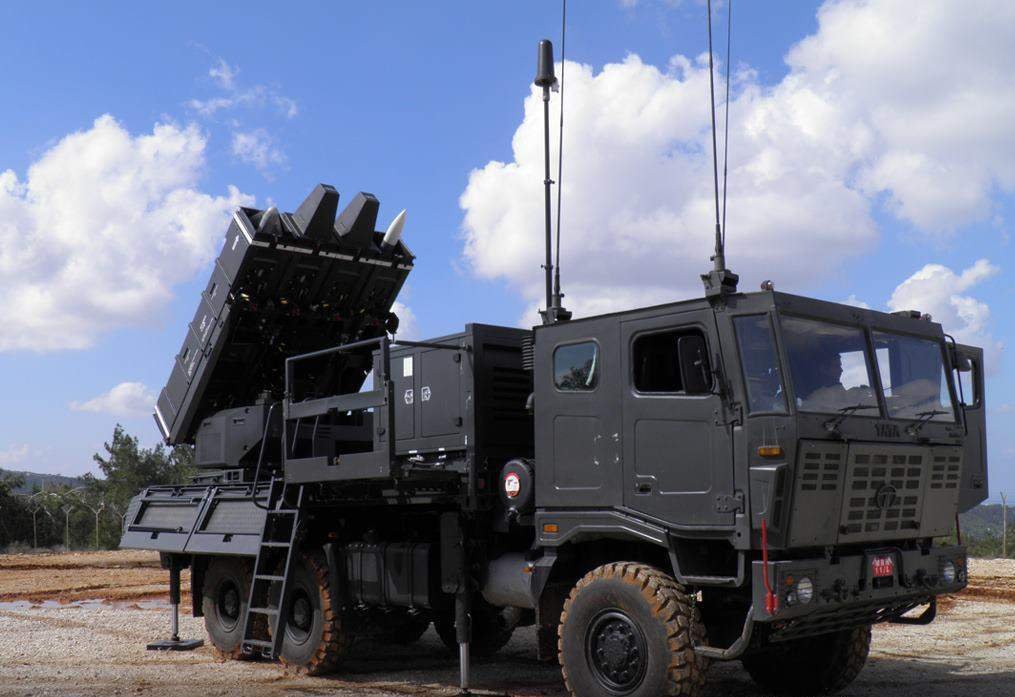
The SPYDER (Surface-to-air PYthon and DERby) is an Israeli short and medium-range mobile air defence system developed by Rafael Advanced Defense Systems with assistance from Israel Aerospace Industries (IAI).
The SPYDER is a low-level, quick-reaction surface-to-air missile system capable of engaging aircraft, helicopters, unmanned air vehicles, drones, and precision-guided munitions. It provides air defence for fixed assets and for point and area defence for mobile forces in combat areas.
The SPYDER launcher is designed to fire Python-5 and Derby surface-to-air missiles which share full commonality with the air-to-air missiles. There are two variants of the SPYDER: the SPYDER-SR (short range) and the SPYDER-MR (medium range). Both systems are quick reaction, all weather, network-centric, multi-launchers, and self-propelled.
A typical battery consists of one central command and control unit, six missile firing units, and a resupply vehicle. The SPYDER-SR uses the EL/M-2106 ATAR radar while the SPYDER-MR incorporates the EL/M-2084 MMR radar. The latter is the same radar used by the Iron Dome system currently in service with the Israel Defense Forces.
IAF currently operates a single squadron of SPYDER and has placed order for 4 more squadrons.
| Warhead | 11 kg (24 lb) (Python-5) 23 kg (51 lb) (Derby) |
| Main armament | ×4 Python-5 or Derby missiles in any combination per MFU |
|---|---|
| Operational range | Python-5:20 km (12 mi) Derby:50 km (31 mi) |
| Flight altitude | Python-5:9,000 m (30,000 ft) Derby:16,000 m (52,000 ft) |
| Maximum speed | Mach 4 |
| Guidance system | Infrared homing and electro-optical imaging (Python-5) Active radar homing (Derby) |
9K33 Osa AK
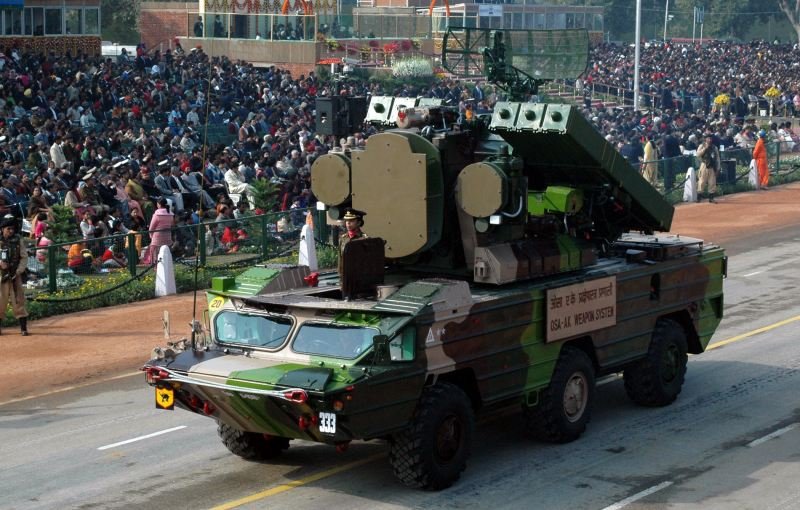
The 9K33 Osa is a highly mobile, low-altitude, short-range tactical surface-to-air missile system designed in the Soviet Union.
Osa was the first mobile air defence missile system incorporating its own engagement radars on a single vehicle. All versions of the 9K33 feature all-in-one 9A33 transporter-launcher and radar vehicles which can detect, track and engage aircraft independently or with the aid of regimental surveillance radars. The six-wheeled transport vehicles BAZ-5937 are fully amphibious and air transportable. The road range is about 500 km.
| Mass | 17.5 tonnes |
|---|---|
| Crew | 5 soldiers |
| Main armament | 6 9M33, 9M33M1, 9M33M2 or 9M33M3 missiles |
| Engine | D20K300 diesel |
| Ground clearance | 400 mm |
| Operational range | 15 to 18 km |
| Maximum speed | 80 km/h, 8 km/h (swimming) |
Missiles
The Osa Ak system used by IAF carries 6 9M33M3 missiles. these missiles have an approximate range of 15 km and maximum speed of mach 3.
Radars
- 1S51M3 (“Land Roll”) – C band target acquisition radar, H band conical scan target tracking radar and two J band pulse mode fire control radars (range 35 km/22 miles for acquisition, 30 km/19 miles for tracking and 25 km/16 miles for guidance). Mounted on the TELAR.
External radars
- P-40 (“Long Track”) – E band early warning radar (range 175 km/108 miles), mounted on a tracked vehicle
- P-15 – 380 kW C band target acquisition radar (range 250 km/155 miles), mounted on a ZiL-131 truck.
- PRV-9 – E band height finding radar ( range 240 km/148 miles), mounted on a KrAZ-255B truck.
2K12 Kub
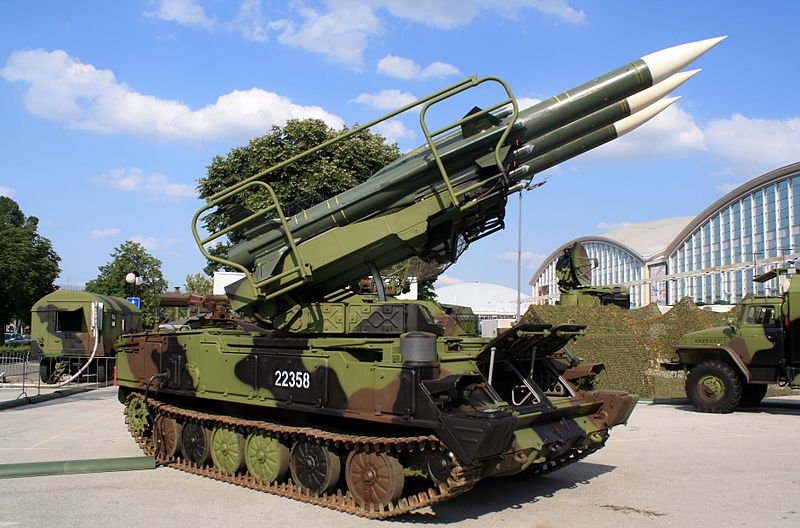
The 2K12 “Kub” mobile surface-to-air missile system is a Soviet low to medium-level air defence system designed to protect ground forces from air attack.
Each 2K12 battery consists of a number of similar tracked vehicles, one of which carries the 1S91 25 kW G/H band radar (with a range of 75 km) equipped with a continuous wave illuminator, in addition to an optical sight. The battery usually also includes four triple-missile transporter erector launchers (TELs), and four trucks, each carrying three spare missiles and a crane. The TEL is based on a GM-578 chassis, while the 1S91 radar vehicle is based on a GM-568 chassis, all developed and produced by MMZ.
| Name | 3M9 ( missile fired from Klub) |
| Mass | 599 kg |
|---|---|
| Warhead | Frag-HE 59 kg |
| Detonation mechanism | Contact and proximity |
| Propellant | integral rocket motor/ramjet booster and sustainer motor |
| Operational range | 24 kilometres (15 mi) |
| Flight altitude | Max. 14,000 metres (46,000 ft) Min. 100 metres (330 ft) |
| Maximum speed | Mach 2.8 |
| Guidance system | semi-active radar homing |
| Launch platform | 2P25 TEL |
Barak 8 “LRSAM”
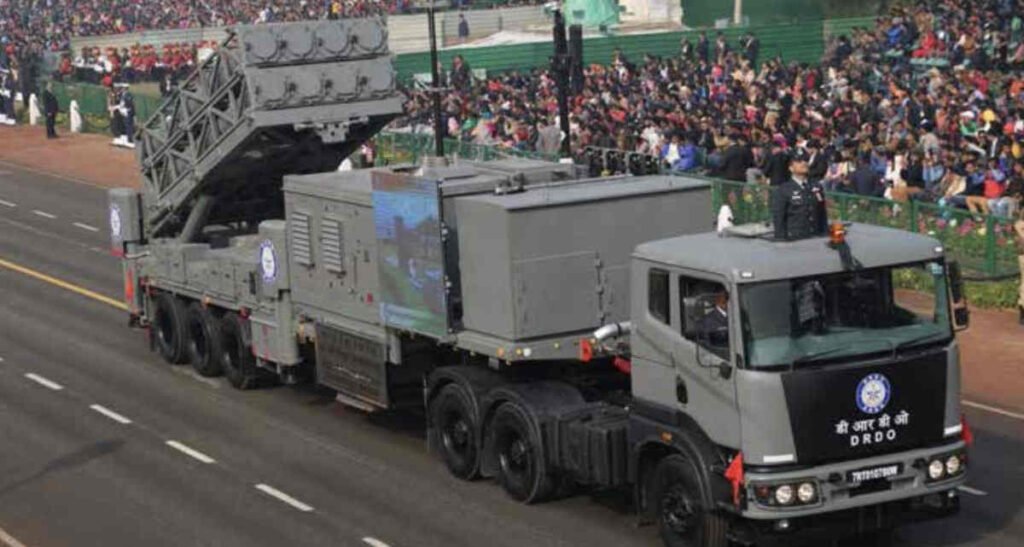
Barak 8 also known as LR-SAM or as MR-SAM is an Indo-Israeli surface-to-air missile (SAM), designed to defend against any type of airborne threat including aircraft, helicopters, anti-ship missiles, and UAVs as well as ballistic missiles, cruise missiles and combat jets.
Barak 8 was jointly developed by Israel Aerospace Industries (IAI), India’s Defence Research & Development Organisation (DRDO), Israel’s Administration for the Development of Weapons and Technological Infrastructure, Elta Systems, Rafael and other companies. Bharat Dynamics Limited (BDL) produces the missiles.
| Engine | Two-stage, smokeless pulsed rocket motor |
|---|---|
| Operational range | 0.5–100 km |
| Flight ceiling | 16 km |
| Maximum speed | Mach 2 |
| Guidance system | Two-way data link Active /IIR seeker |
| Launch platform | 8 cell VLS module, 8 cell, double stacked land launcher |
Key Features
- Long Range
- Two-way data link (GPS S-band)
- Active Radar Seeker Missile
- 360-degree coverage
- Smokeless propulsion
- Thrust vector control
- Dual pulse propulsion
- Vertical Launch
- Multiple Simultaneous Engagements
- Point defence anti-ballistic missile
All the three services Indian army, Indian Air Force and Indian navy uses Barak 8. Recently this system was also deployed in Ladakh to Counter china.
Quick Reaction Surface-to-Air Missile (QRSAM)
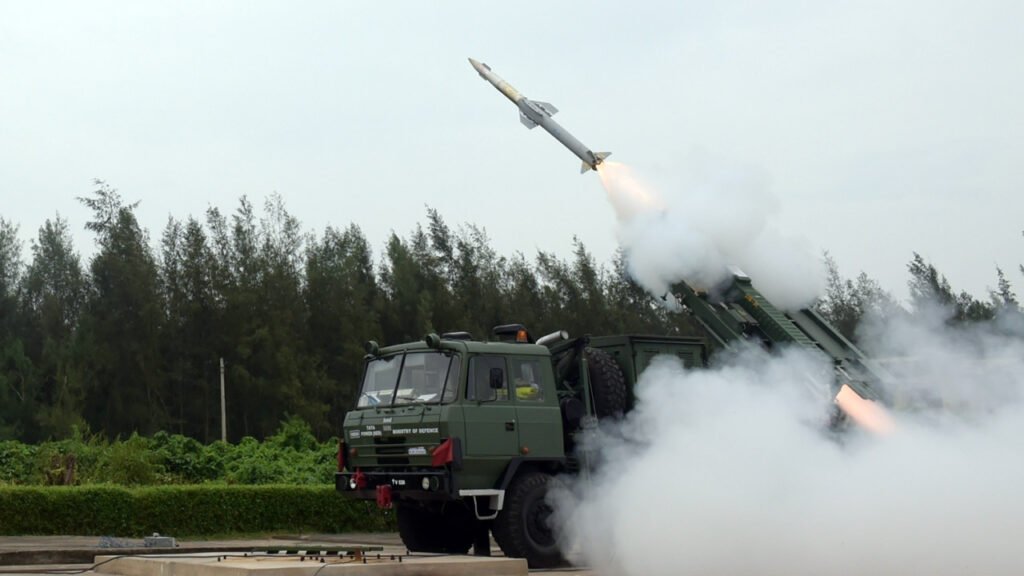
Quick Reaction Surface-to-Air Missile (QRSAM) is a missile developed by the DRDO in association with Bharat Electronics Limited and Bharat Dynamics Limited for the Indian Army.
This missile is an all-weather, all-terrain SAM equipped with electronic countermeasures against jamming by aircraft radars. The missile can be mounted on a truck and is stored in a canister. QRSAM uses solid-fuel propellant and has a range of 25–30 km. The single-staged missile uses solid propellants for propulsion. The missile is equipped with a midcourse inertial navigation system with a two-way data link and a DRDO-developed terminal active seeker. The system has the capability to search and track targets while moving
QRSAM is a compact weapon system and is mobile. It has a fully automated Command and Control System. The missile system comprises two four-walled radars both of which encompass a 360-degree coverage, namely, the Active Array Battery Surveillance Radar and the Active Array Battery Multifunction Radar, apart from the launcher.
| Propellant | Solid fuel |
|---|---|
| Operational range | Missile: 3 km (1.9 mi) – 30 km (19 mi) |
| Flight altitude | 30 m (98 ft) – 6 km (3.7 mi) |
| Maximum speed | 4.7 Mach |
| Guidance system | Mid-course: Inertial navigation system with two way datalink Terminal: Active radar homing |
| Transport | BEML-Tatra T815 8WD |
Recently indian Army has deployed QRSAM in Ladakh to counter china
S-200
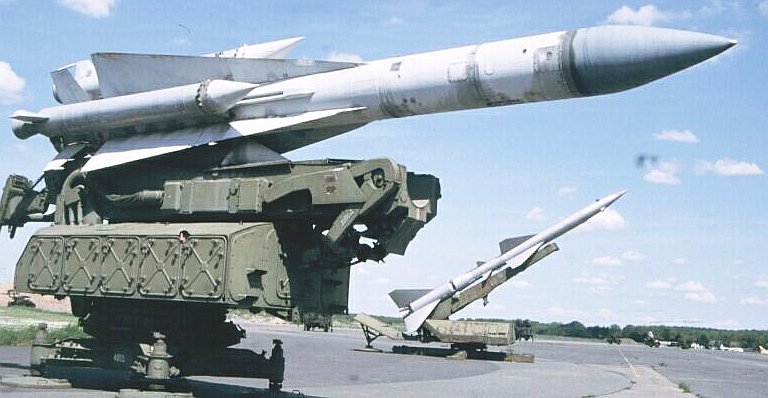
The SA-5 Gammon (Russian name S-200 Angara/Vega) is a low- to high-altitude very long-range surface-to-air missile system designed to defend large areas from bomber attack or other strategic aircraft. Initial deployment of an S-200 trials unit using the original 5V21 missile took place from 1963 to 1964 on the outskirts of Tallinn in Estonia. The first operational regiments were deployed in 1966 with 18 sites and 342 launchers in service by the end of the year.
In 1989, India purchased two S-200 Angara systems and 24 5V21 missiles from the Soviet Union. Today, the S-200 augments India’s lower altitude air defences as the country pursues more advanced ballistic missile defence capabilities, such as its Prithvi Air Defense (PAD) and Advanced Air Defense (AAD) missile interceptors. According to some unconfirmed sources, this system was retired in 2015.
| Mass | 7,100 kg (15,700 lb) |
|---|---|
| Warhead | 217 kg Frag-HE |
| Detonation mechanism | proximity and command fusing |
| Propellant | dual-thrust liquid-fueled rocket motor |
| Operational range | 300 kilometres (190 mi) |
| Flight altitude | 40,000 metres (130,000 ft) |
| Boost time | 4 solid-fueled strap-on rocket boosters |
| Maximum speed | Mach 4 (4,900 km/h; 3,045 mph)[6] |
| Guidance system | semi-active radar homing seeker head |
Very Short Range interception (less than 10km)
These defences are the last-ditch weapon against any incoming areal threat. IAF and Indian army uses anti-aircraft guns and MAN Portable Air Defence Systems (MANPADS).
9K35 Strela-10

The 9K35 Strela-10 is a highly mobile, visually aimed, optical/infrared-guided, low-altitude, short-range surface-to-air missile system. The Strela-10 system was originally designed to use the 9M37 missile as its primary weapon.
Each 9M37 missile is 2.2 m long, weighs 40 kg and carries a 3.5 kg warhead. The maximum speed of the missile is near Mach 2, engagement range is from 500.to 5000 m (0.3–3 miles) and engagement altitude is between 10 and 3500 m. Four missiles are mounted on the turret in boxes, ready to launch, and eight more are carried inside the vehicle as reloads. Reloading takes around 3 minutes.
| Mass | 41 kg |
|---|---|
| Warhead | 5 kg Frag-HE |
| Detonation mechanism | contact and laser proximity fuzes |
| Propellant | single-stage solid-propellant rocket motor |
| Operational range | 5 kilometres (3.1 mi) |
| Flight altitude | 3,500 metres (11,500 ft) |
| Maximum speed | 550 m/s |
| Guidance system | dual-mode passive ‘photocontrast’/IR seeker |
2K22 Tunguska

The 2K22 Tunguska is a Russian tracked self-propelled anti-aircraft weapon armed with a surface-to-air gun and missile system. It is designed to provide day and night protection for infantry and tank regiments against low-flying aircraft, helicopters, and cruise missiles in all weather conditions.
| Mass | about 35,000 kg (77,000 lb) |
|---|---|
| Crew | 4 (vehicle commander, driver, gunner, radar operator) |
| Armour | protects the vehicle from 7.62 mm small arms fire and shell splinters |
| Main armament | 8 × 9M311, 9M311K, 9M311-1, 9M311M, 9M311-M1 or 57E6 missiles |
| Secondary armament | 2 × 30 mm 2А38M guns (1,904 rounds carried) |
| Operational range of Vehicle | 500 km (310 mi) |
| Maximum speed of vehicle | 65 km/h (40 mph) maximum on the road |
ZSU-23-4 Shilka
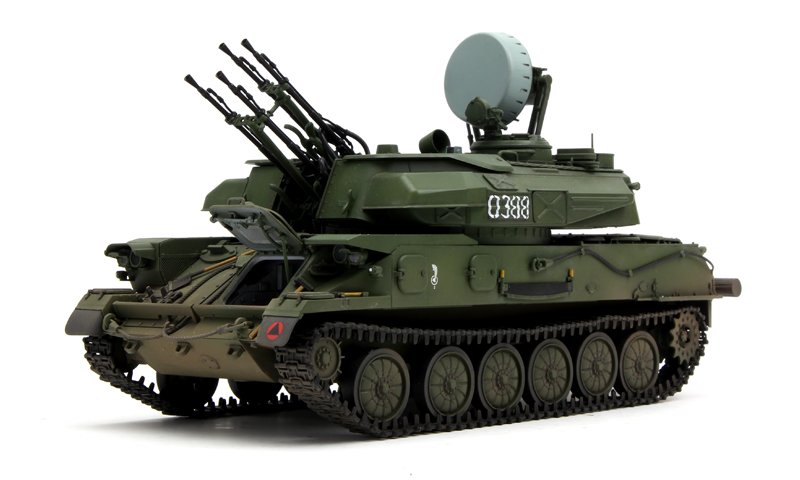
The ZSU-23-4 “Shilka” is a lightly armoured Soviet self-propelled, radar-guided anti-aircraft weapon system. These are used by the Indian Army in limited numbers.
The main armaments are 4 × 23 mm 2A7 autocannons (AZP-23 “Amur” quad automatic anti-aircraft gun), ammunition 2,000 rounds.
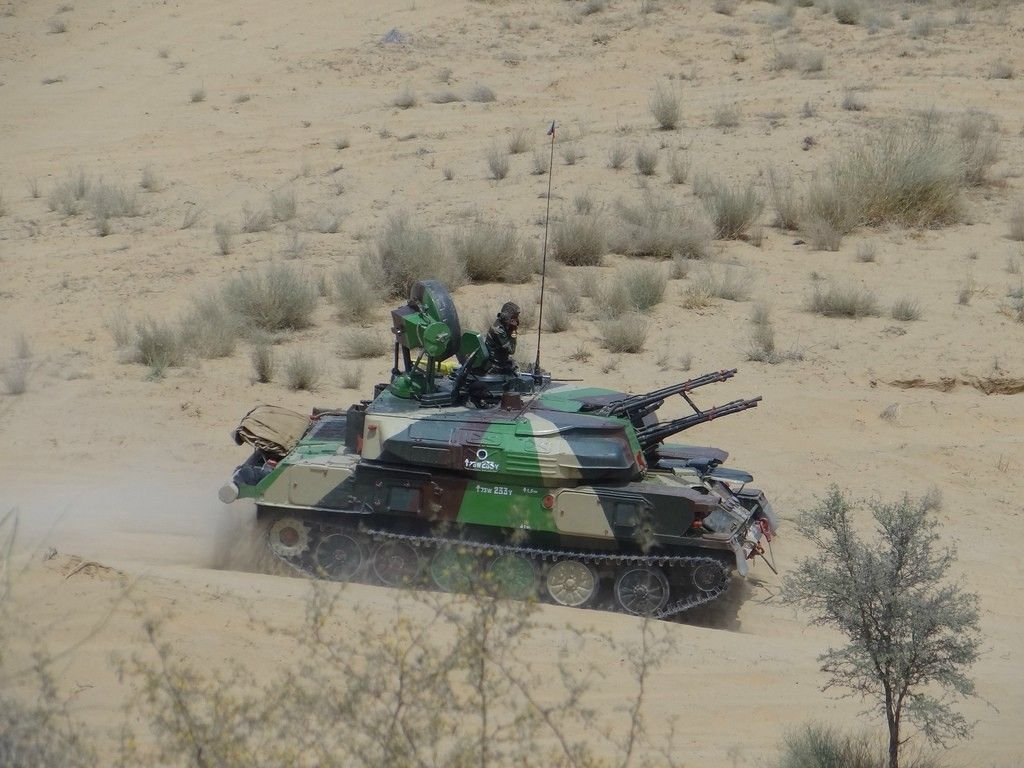
ZU-23-2

The ZU-23-2, also known as ZU-23, is a Soviet towed 23 mm anti-aircraft twin-barreled autocannon
| Shell | 23x152B |
|---|---|
| Caliber | 23 mm |
| Barrels | 2 |
| Action | Gas operated |
| Elevation | −10° to +90° |
| Traverse | 360° |
| Rate of fire | 2000 rpm cyclic, 400 rpm practical |
| Effective firing range | 2.5 km (2 mi) effective range |
Bofors 40 mm gun
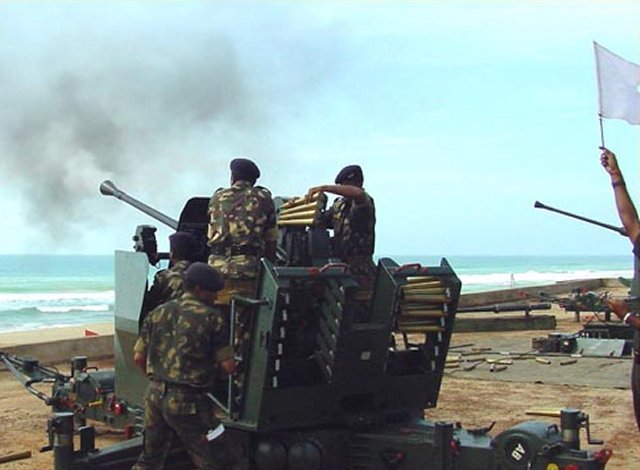
The Bofors 40 mm gun, often referred to simply as the Bofors gun, is an anti-aircraft autocannon designed in the 1930s by the Swedish arms manufacturer AB Bofors.A small number of these weapons are still in service with the indian army.
| Shell | 40×365 mm R |
|---|---|
| Shell weight | 0.9 kg |
| Calibre | 40 mm |
| Carriage | 522 kg |
| Elevation | −20°/+80° (57°/s) |
| Traverse | Full 360°, 92°/s |
| Rate of fire | 240-330 round/min |
| Muzzle velocity | 1,021 m/s |
| Maximum firing range | 12,500 m |
KPV heavy machine gun

In the post-World War 2 period, Soviet forces inducted a new heavy machine gun known as KPV-14.5 (Krupnokaliberniy Pulemyot Vladimirova). The weapon was in development as far back as 1944 and chambered for fire the same massive 14.5×114 mm cartridge used by the Degtyaryov PTRD Anti-Tank Rifles (ATRs). Since its introduction in 1949, the KPV has gone on to see fielding as a vehicle-mounted/coaxial machine gun, dedicated Anti-Aircraft (AA) gun, and naval/watercraft machine gun.
This gun is locally manufactured by the Ordinance Factory Board Trichy and is used as dedicated AA gun. These guns are used on quadruple Gun Mounts.
| Cartridge | 14.5×114 mm |
|---|---|
| Calibre | 14.5 mm |
| Action | Short recoil operation |
| Rate of fire | 600 rpm |
| Muzzle velocity | 1,005 m/s (3,297 ft/s) |
| Effective firing range | 3000m |
| Maximum firing range | 4000m |
| Feed system | 40-round belt |
| Sights | iron or optical |
AZP S-60

The AZP S-60 is a towed single barrel 57 mm anti-aircraft gun of Soviet origin. It was designed just after World War 2 to replace the older models. It was also known as the S-60. It can be used as a standalone weapon or used in conjunction with fire control and radar. During several wars, it proved to be a potent weapon system.
| Shell | Fixed QF 57×348mmSR |
|---|---|
| Caliber | 57mm (2.24 in) |
| Action | Recoil operated |
| Carriage | Four wheels with outriggers |
| Elevation | −4° to +85° |
| Traverse | 360° |
| Rate of fire | 105–120 rpm (cyclic) 70 rpm (sustained) |
| Muzzle velocity | 1,000 m/s (3,281 ft/s) |
| Effective firing range | 6,000 m (20,000 ft) (radar guided) 4,000 m (13,000 ft) (optically guided) |
MANPADS
Indian Army, Air force and Navy use 9K38 Igla-s as the primary MAN Portable Air Defence System. however army also uses Stinger missiles in limited numbers.
9K38 Igla-S
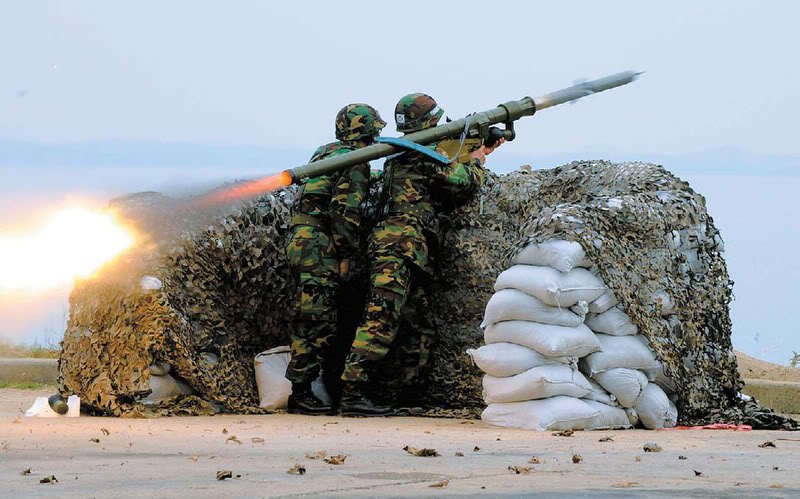
It is the primary MANPADS of all the three services used in large numbers. It is Soviet equivalent of Stinger Missile. Indian Army is currently procuring fresh lots of Igla-S from Russia.
| Unit Cost | $60,000 |
| Engine | Solid fuel rocket motor |
|---|---|
| Warhead | 1.17 kg with 390 g explosive |
| Operational range | 6.0 km |
| Flight ceiling | 3.5 km |
| Maximum speed | Mach 1.9 |
| Guidance system | Dual waveband infra-red |
“Never Forget that your weapon was made by the lowest bidder”
Unknown
FIM-92 Stinger

The FIM-92 Stinger is a man-portable air-defence system (MANPADS) that operates as an infrared homing (SAM). Indian Army uses Stinger in very limited numbers due to its high cost.
| Unit cost | $80,000 |
| Warhead | 3 kg High explosive annular blast fragmentation |
|---|---|
| Engine | Solid-fuel rocket motor |
| Guidance system | Infrared homing |
| Range | 4,800m |
| Speed | Mach 2.2 |
These were all the air defense systems used by the indian armed forces. India has multiple layers of air defense systems and when the S-400 air defense system will be inducted, it will increase the air defense capabilities by many folds.



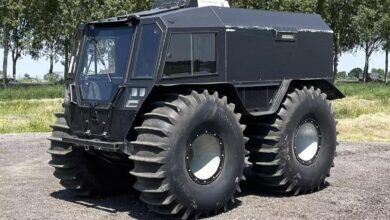


Very informative. Thanks
I believe when Integrated Air Defence Command is established, we will have a foolproof Air Defence.
Many missiles are way too heavy and might end being dodged by jet fighters.
Just look at S-200 records : S-200 only managed to shoot down 3 heavies, 2 being airliners, one beng a Russian Il-22M by friendly fire. A single jet fighter was downed, this F-16 was back from a mission, flying over Israel with ECM and RWR off while pilot and WSO were already debriefing the mission while still onboard.
S-400, even Kub etc have way too heavy missiles too.
A S-200 warhead weights 200kg+… Replacing this with two MICA-IR then you have something REALLY devastating… And no radar-locking warning… If you use data from an OTHR like the Nostradamus radar (accuracy 5km at 3000km), no issue at targetting stealth aircraft : the IR seekers will be there for it.
Another bad point : SAM+radar sites and airbases are priority targets for the enemy, so you can be sure these are at the receiving end of ballistic+cruise missiles and drone swarms…Better have very serious CIWS/C-RAM of the likes of NBS MANTIS : the first thing NATO does at war is SEAD!
Very useful and informative article.
My best wishes for your future endeavors.
According to Wikipedia India uses S-300. Is it true?
No…India just uses the radars of s 300 in S 200 and S 125
I read somewhere that S-300 were Procured to secure Delhi and Mumbai and other important city
Hello sheershoo. As someone closely related to our safeguarding out national interests i thank you for compiling this article.
Very informative.
Sheersho Deb, may your dreams come true.
so deep.. so good… very reasearched..
What a super article. Thank you
Undoubtedly, hands down, this was a very well-researched and analyzed article I came across!
Great Work brother.
Good article! 🙂 Small typo SPYDER’ Python-5 warhead weight is 11kg. By mistake it was mentioned as 1kg.Weight in lbs is proper.
Thanks
~Prasad
Thanks for the correction. We appreciate it.